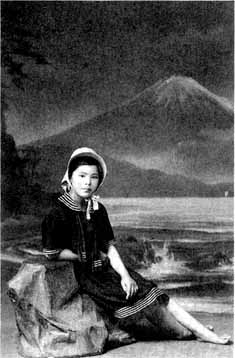
|
Traces That Remain:
A Pictorial History of the Early Days of the Bahá'í Faith among the Japanese
by Barbara R. Sims
edited by Sheridan Sims  |
chapter 11 | start page | single page | chapter 13 |  |
Chapter 12
Miss Mochizuki as a lovely girl of seventeen. It was taken in a professional photographer's studio at Ejiri.
37
Miss Alexander wrote that each morning before Miss Mochizuki went to work they read a verse from "The Hidden Words of Bahá'u'lláh" so that she could understand the meaning. In this way she translated the small book into Japanese. She has updated the style somewhat but her basic translation is still being used.
'Abdu'l-Bahá favored this young woman with three Tablets. He wrote to her, "Japan is like unto a farm whose soil is untouched. Such a soil as this has great capacity. One seed produces a hundredfold."
In 1920 Miss Mochizuki and Miss Alexander decided to publish a Bahá'í journal, which they called the "Star of the East" (Higashi no Hoshi). The first issue was dated October 19, 1920.
It was edited by Miss Mochizuki with the help of Mr. Ono. As Tablets from 'Abdu'l-Bahá to the Japanese were received, they were put into the journal.
When 'Abdu'l-Bahá was notified of the journal He wrote to Miss Mochizuki, "At present thou has started a journal. It is my hope that this journal will shine as a Star of the East." He wrote a long Tablet advising Miss Mochizuki what to put in the journal. (See "Japan Will Turn Ablaze!" for the complete Tablet.)
After editing, proofreading and sending out the "Star of the East" for one year, Miss Mochizuki left Japan to go to France. Mr. Kenji Fukuda, who had been a Christian minister before he found the Faith offered to edit the magazine. With the assistance of Miss Mikae Komatsu it continued for one more year.
 |
chapter 11 | start page | single page | chapter 13 |  |
|
|
